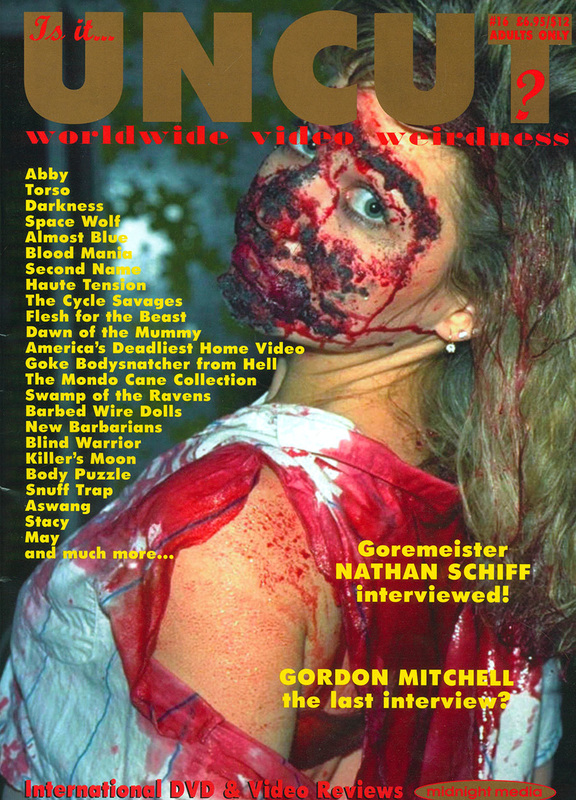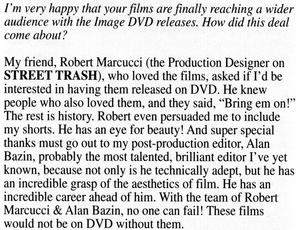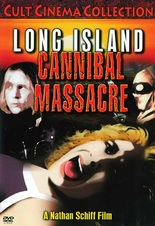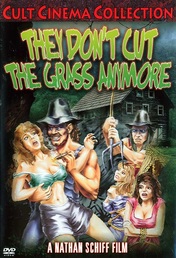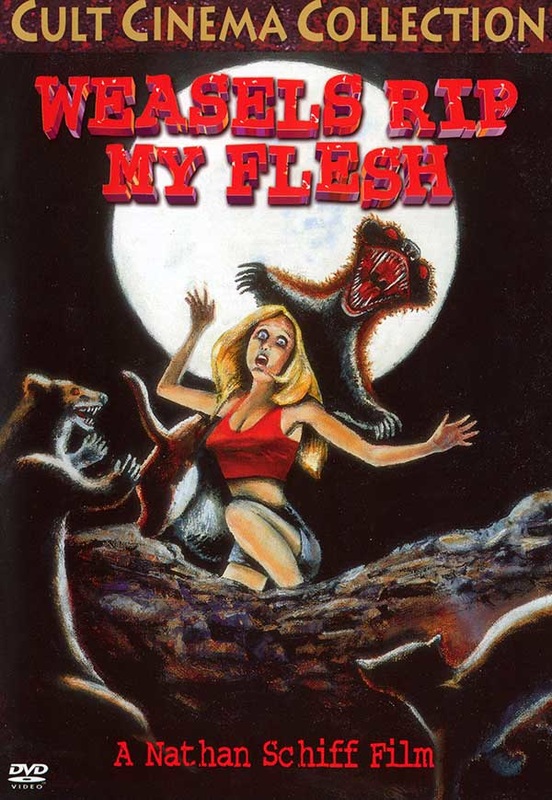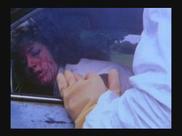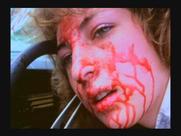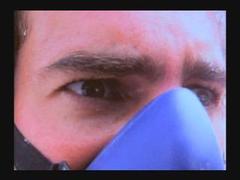|
Excerpt from Uncut Magazine issue #16
|
Working through my old, home based editing studio Digital Shark in NY, I teamed with cult filmmaker Nathan Schiff to reconstruct, re-edit and remaster his rare, infamous, super 8 horror films in preparation for DVD release by Image Entertainment. The project was brought to me by Producer Robert Marcucci, and proved to be an enormous challenge which I was asked to detail by Uncut magazine, who ran my account along with Nathan's interview. I also completed work on a fourth film of Nathan's, the notorious "Vermillion Eyes," however it was was rejected by Image Entertainment for what was described as "upsetting content." (Unlike Nathan's other films, "Vermillion Eyes" has a serious and disquieting mood, and it's also arguably his best film and certainly his most accomplished feature.) "Long Island Cannibal Massacre," "They Don't Cut the Grass Anymore," and "Weasels Rip My Flesh" were released without incident and continue to be available on DVD.
To read the story of how I turned Nathan's non professional, dog eared elements into digital masters that could be released by Image Entertainment, the text from the Uncut magazine article is featured below. Looking back, I was rather melodramatic and self congratulatory, but hopefully you can stomach it. |
Click on the above images to see
the back of the DVD releases. Three video stills from the unreleased "Vermillion Eyes."
|
|
When we finally gathered all the elements from Nathan's films together and I saw what we had to work with, I thought back to the day years ago when I saw the Elite laser disc of "Night of the Living Dead." I remembered what an impact the opening moments had on me, where they ran a few moments from one of those crappy, washed out prints we'd all seen for years and then it explodes, followed by a beautiful, restored version. It gave me the chills because I was watching a film I loved, and I knew that some people out there had gone through a lot of time and trouble to show that they loved it too by treating the film with reverence, and the fans who loved it with respect. Since both Robert Marcucci, the producer of the DVD releases, and I are both true blue fans of rare and original horror cinema, we talked about how we wanted to treat the release of Nathan's films in the same way, if we could. I half-jokingly said that it would be great if we could somehow pull off making these the "no-budget THX digital restorations" of Nathan's work. Knowing that we had practically no money, tons of rather unprofessional no budget film and audio elements to work with, an enormous amount of sound replacement to do and only a few weeks to complete everything and deliver the masters to Image, this was a ludicrous idea. But it became our underlying philosophy and we committed to doing whatever we could to give these films a royal treatment. With regard to how Nathan's films were prepared for this DVD release, the sole shining new element I had to start with was a terrific new Film to Tape transfer Nathan and Robert had done at Super-8 out on the West Coast. But because there are no negatives for any of Nathan's films (being Super 8), only the original, spliced prints he used to carry around and project himself at places like the Dive in NY, this presented two new problems. First, as every splice passed through the film to tape transfer machine, the image jumped, lost registration, changed color or sharpness, or had some tape artifacts visible for a few frames, resulting in a jarring distraction with each cut. So the first thing I decided to do was fix every edit point by extracting as few frames as I could to create a smooth cut. Luckily, back when Nathan originally spliced his films, he had become aware that when he projected his prints there would always a bit of a jump at each edit point, so he had made most of his cuts with a bit of extra room, sometimes even resulting in some awkward moments where actors appeared to be waiting for the camera to start rolling. This was a Godsend for me, however, because it meant that I could trim down the edits and smooth out all the cuts without losing any crucial visual information or creating continuity or flow problems. It did, however, mean that I had to spend hours upon hours fixing every single one of the hundreds of edits in Nathan's films. But I felt this was crucial to making the image as watch able as possible, without the constant invasion of jumps and other visible anomalies to distract you. Another problem the new film transfer posed was that, since Film to Tape transfer machines are not typically created to transfer sound, the audio we now had to work with sounded like it had been played through an old car radio. It was tinny, devoid of any low end, muffled and much of the dialogue was indecipherable. If we were to have used it, the resulting soundtrack would have been painfully difficult to listen to. So I decided we would have to use some of the sound elements from Nathan's old masters, and rent a projector to run his prints in my studio where I could digitize the original split tracks coming off the film directly into my Avid. The amazing headache this presented was, because Nathan's films had never been run on a synchronized projector (one truly running at the exact correct frame rate), all of these superior audio elements now ran at a different frame rate than the picture. This meant every single line of dialogue and all of the original sound effects in each film had to be re-synchronized to match the picture. We then discovered that a number of the original audio tracks Nathan had believed were completely split carried bleeds from the other track, meaning they were not usable and would also have to be replaced. |
Another major challenge was the fact that I had to replace a great majority of the music and even a number of sound effects originally used in Nathan's films due to copyright issues. But because there was no money to pay for stock music or involve an audio engineer or composer in any capacity, Nathan instead searched his collection of public domain films and music and came to my studio with a suitcase full of VHS tapes and CDs. We then had to go through each film, scene by scene, to remove the offending music and sound effects, then search for and cobble together replacements. This was quite laborious as we frequently found ourselves running out of music we could use or get to work with a particular scene. And then of course the levels for all these audio elements had to be remixed. In the end, it was most gratifying to hear Nathan say he was much happier with the new soundtracks we created together than he was with the originals. With "Weasels Rip My Flesh" we had an additional, potentially catastrophic problem with the original elements. It was the first feature Nathan made, and consequently he had shot it at 18fps rather than 24fps. When we reviewed the tape transfer, it became clear that the motion of the image was irregular and unnatural, jittery, for lack of a better term. It resembled what those "Accu-speed" versions of silent films like "Nosferatu" come out looking like. Nathan was devastated, because this meant the film was most likely going to be rejected by Image. After consulting with the transfer technician and a few other post production professionals, I was told there was nothing we could do to solve this problem, that it was a natural by-product of a 18fps transfer. The night we learned this, I still remember how crushed Nathan was when he left my studio. I became determined to find a way to fix the problem so we could return to focusing on the rest of the work we had to do, and also to take a huge weight off both Nathan's and Robert's shoulders. I decided to try an experiment and took a small section of the tape transfer, then created a motion effect (essentially speeding up the film slightly) while telling my Avid software to interpolate the two video fields as it created these clips, which I hoped would smooth out the motion of the image without degrading the quality. The resulting clip was a great improvement, removing much of the undesirable herky-jerky quality. A video transfer of "Weasels" will never look as natural as it would if it had been shot at 24fps, but I knew we now had an image presentable enough to be released and viewed with minimum distraction. It had been somewhat of a long grueling day, but I knew Nathan really needed a pleasant surprise. So I stayed up the rest of the night, reconstructing the entire film (mercifully Nathan's shortest) so that the image was now virtually jitter-free and had been re-synchronized to the original dialogue and sound FX track (which ran at a different speed). When Nathan returned to my studio the following morning, it was great to watch his jaw drop when I showed him the good news. It also felt really good to know that now nothing would prevent "Weasels" from being seen and appreciated. There was no way we could fix all of the sound and image "imperfections" inherent in Nathan's films. Film scratches and audible camera noise on the dialogue track are just two examples of the many rogue qualities that remain untouched and intact. Most are the understandable by-products of making these movies on a non-existent budget and having only one edited print of each film for all this time. But the imperfections are an undeniable part of their authenticity, charm and improbable creation. One wouldn't want to alter them too much for fear of aesthetic contamination. It has been a truly gratifying experience to watch these films go from the murky, jumpy, old VHS masters Nathan himself had been forced to lend people for years, to the best possible digital reconstruction and remastering we could manage. In some ways, it's remarkable that these incredible cult time capsules have survived, and it's a minor miracle they are now being seen by such a wide audience. What Robert and I had hoped to do was to create these DVDs from the best elements that will ever exist, and to create the ultimate video presentation of Nathan's truly unique (and truly home-made) Super 8 feature films. I'm proud to say I believe we somehow managed to accomplish exactly that. From the article on Nathan Schiff featured in Uncut Issue #16
|
Video, Photographs and Content by Alan Bazin © 2021
